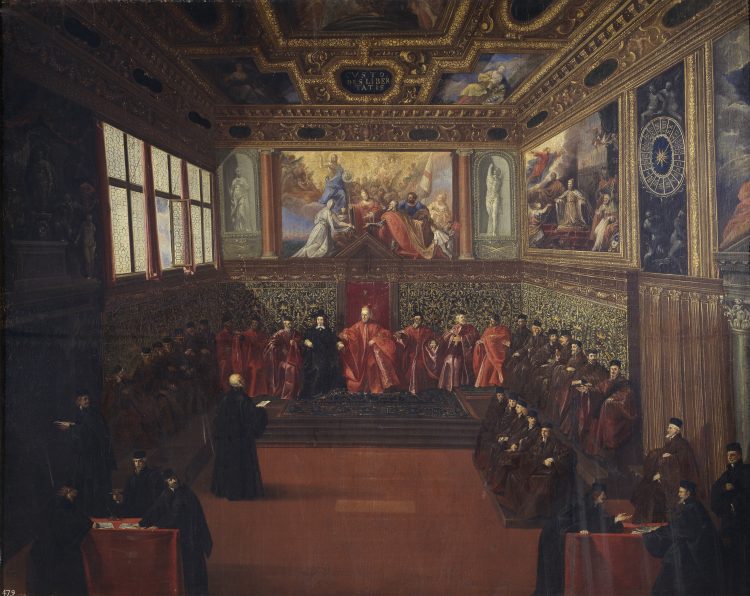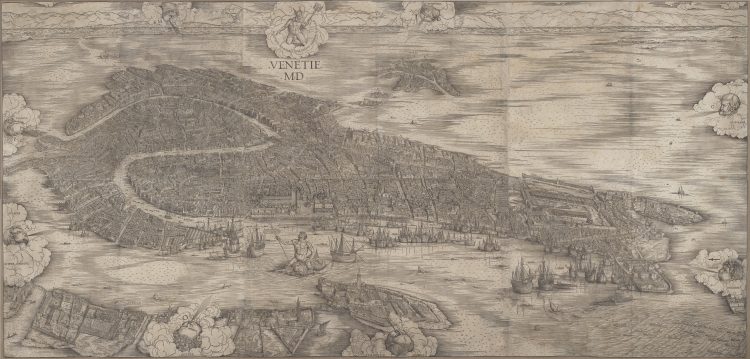Papering over protest in sixteenth-century Venice
15 Jun 2022|Filippo de Vivo
- Research
![Habiti_d'huomeni_et_donne_venetiane_[...]Franco_Giacomo_btv1b8447141m_10 Habiti d'huomeni et donne venetiane, con la processione della Serma Signoria et altri particolari, cioè trionfi, feste et cerimonie publiche della nobilissima città di Venetia.](/asset/Habiti_dhuomeni_et_donne_venetiane_...Franco_Giacomo_btv1b8447141m_10-466x750.jpeg)
Historians search archives, libraries, museums for traces of past lives and ideas. We never take sources at face value and we know they were often produced for partisan purposes generally by a tiny minority of people. For this reason, source criticism is a basic component of the training we receive and give our students – and we believe it makes for vital lessons in comprehending today’s world too. A classic problem arises for example when we want to study pre-modern rebellions. Most of the sources were produced by authorities intent on punishing rebels, so we have to draw evidence from hostile accounts. But what if we have no sources at all?
In a recent article researched and written with Maartje van Gelder of the University of Amsterdam, we argue that the absence of evidence is itself a form of evidence. Our case study is Venice, the Serenissima or most serene republic that throughout the Renaissance epitomised social peace and political harmony. Today historians rightly regard this as a ‘myth’, maintained in art, literature, architecture, and ceremonials. The reality was much more complex. In reality there was a high degree of disagreement in the ruling nobility and dissent in the population. This was after all both an aristocratic republic and, thanks to its renowned arsenal, the site of perhaps the largest and densest concentration of manual workforce in pre-industrial Europe. As one expects, workers engaged in strikes and other forms of collective action to improve salaries or working conditions. Yet such acts are rarely if ever mentioned in the sources – which is why most historians have failed to pay attention.
To understand popular protest, we need to turn to chronicles and letters written by foreign diplomats and outsiders. For example on 12 March 1569 – as all Saturdays were a payday, and normally the scene of happy and orderly home-going after a hard week’s work celebrated in the picture above – these sources tell us that hundreds of workers stormed out of the Arsenal gates to protest a cut in their wages and the revocation of workers’ rights which came into force that day. Armed with their tools – hatchets, hammers and long hooks called ‘evil beasts’ – they marched onto the seat of government. They broke into the Ducal Palace and reached the hall of the Republic’s cabinet, which was then sitting. What happened next is unclear, because government records don’t even mention this incident. Foreign ambassadors (who notoriously had trusted informers in the Palace) suggest that there was a protracted confrontation until Venice’s most influential leaders assured the workers that the government would see to their case and not fail to do all that was convenient. At this point the workers left.

Much ado about nothing? This is exactly how most historians have treated this event in brief footnotes because government archives reveal very little about it. But this is the point. What makes the sources’ scarcity especially puzzling is that the official records of government were written in the very halls where the workers entered by force. Secretaries at their desks as in the foreground of this picture compiled careful records of that day’s council business, but made no mention of workers. Hundreds of protesters, yet not even a blot of spilled ink. What does this show?
It turns out that the myth of Venice’s social and political peace was maintained not only in art and ceremonial, but in the archive itself. Historians tend to view archives as tools to unmask myths, but archives are themselves products of particular ideals. In our research we uncovered the subtle ways in which record-makers elided protesters. In March 1569 as for hundreds of years, the minutes of government councils were transcribed and polished several times before being inscribed onto thousands of wood-bound parchment codices which avoided all references to disagreement or dissent. So these government documents are in fact also monuments to a particular idea of government – and this mattered very much since sixteenth-century official historians already researched their histories in archives. In the weeks and months following the protest, then, the authorities prosecuted the protesters but covered their enquiries with studied ambiguity. For example they referred to the workers who have ‘come to the Ducal Palace in the way they have’. They then maintained their records under special secrecy. And finally they buried every mention of discontent under many documents affirming consensus – a process we described as ‘papering over protest’.

It is not easy to uncover the events behind these equivocations, and it requires comparing hundreds of different sources, chronicles, outsiders’ reports, diaries, newsletters and private letters while also looking for hidden clues in government records. Doing so revealed a starkling fact. In 1569 after protracted months of contentious action, workers actually won the day: their pay and their rights were restored. The government evidently found it much easier to control the archives than to impose its will on the workers. Hidden inside the archives and their silences we find traces of a vibrant and diverse population, making this beautiful city an even more fascinating place to study.
Category: Research
Author

Filippo
de Vivo
Filippo de Vivo studied in Milan, Cambridge and Paris, and worked for eighteen years at Birkbeck before joining Teddy Hall in October 2021. He teaches early modern European and world history, with special emphasis on Italy and the Mediterranean.